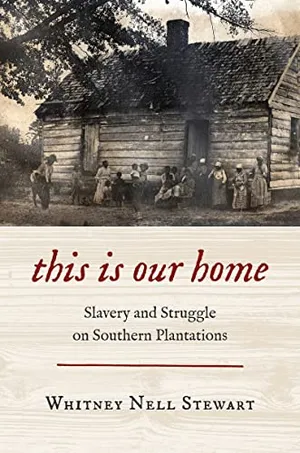Some Black Americans are reclaiming antebellum estates as part of their family legacy, reflecting the power and possibility of these historic sites
Breanna Henley had a powerful, inspired idea. To document her 2021 graduation from dental school, she donned her Alpha Kappa Alpha colors and academic regalia, then strode confidently toward the camera. Before her was the ground that her ancestors cared for generations ago. Behind her stood the cabin where her great-great-great-great-grandparents, Lucy and Anthony Henley, lived while enslaved at Redcliffe Plantation in South Carolina.
Asked why she chose this setting, Breanna noted the sense of immediate “attachment” and “belonging” she felt there. Captioning a photograph of herself on Instagram, she wrote, “I stand tall on the soil of MY ancestors. I stand directly where the Henley family legacy began out of sacrifice and perseverance.”
This Object in History: F-14 Tomcat
This March, Henley returned to Redcliffe to claim that legacy alongside three generations of her family. At the historic site’s Descendants’ Day, the Henleys collectively continued a tradition that extends back to 1857, when their ancestors were forced onto a new plantation by their enslaver, James Henry Hammond. Despite Hammond’s brutal enslaving tactics, the modern-day Henleys feel connected to this place. It is their ancestral home, their family legacy. But it wasn’t supposed to be.
Some historians and activists have called for plantations like Redcliffe to be renamed slave (or forced) labor camps. Others have asked whether these physical remnants of slavery should be demolished like Confederate monuments.
Plantation tours that downplay the brutal violence of slavery distort historical truth. But those who see plantations solely as sites of exploitation can’t explain why the Henleys keep coming back to Redcliffe. The usefulness and power of these places rests in their ability to tell multiple stories at once: white supremacy and Black resistance, loss and hope, slavery and freedom. A plantation like Redcliffe has the potential to do much more than what Hammond originally designed it to do.
Among the most prominent pro-slavery politicians of the 19th century, Hammond was an ardent white supremacist. In an 1858 speech, he famously declared that “cotton is king” and that Black Americans are, by nature, destined to be the “mud-sill” of American society. “Such a class you must have,” he said, “or you would not have that other class which leads progress, civilization and refinement.” As he’d argued earlier, “Slavery is an established and inevitable condition to human society.”

Hammond likewise wanted Redcliffe, a plantation he bought in 1855, to be an “established and inevitable” presence on the Southern landscape, a legacy he would pass down to future generations. At the time he acquired the property, Hammond already owned thousands of acres of land on multiple contiguous plantations along the Savannah River. His expansive South Carolina estate was built on the coerced labor of more than 300 enslaved individuals. Fixated on increasing his profit and proving his power, Hammond imposed a hellish work regimen and demanded strict adherence to his exhaustive list of rules. He even wrote a plantation management manual detailing what he argued were the “best practices” for extracting the most from an enslaved workforce.
Even as the nation devolved into civil war, Hammond’s thoughts turned to his descendants’ permanent presence at his new property: “My only earthly ambition and desire is to secure Redcliffe as a family residence [for] my children,” he wrote in early 1861. To state the obvious, he was referring solely to his white children. Hammond fathered at least two children by two enslaved women, a mother and daughter named Sally and Louisa Johnson. He justified this sexual violence and countless other acts of brutality with lofty references to antiquity, including his position as pater familias. But Hammond built Redcliffe for only one part of his so-called “large family here, over 60 Black and white.” He built it for the Hammonds, not the Johnsons, the Henleys or other families he enslaved.
When visitors first walk the grounds of Redcliffe, now a state historic site, they might assume that the plantation is a monument to what Hammond believed, desired and demanded. His interest in ancient history went beyond his justifications for slavery, expressing itself in the imposing Greek Revival mansion that he had built at the property’s highest elevation. Behind and below it stood four slave cabins, painted in the same bright white and green hues yet dwarfed by the mansion—a material declaration of Hammond’s mud-sill theory.
/https://tf-cmsv2-smithsonianmag-media.s3.amazonaws.com/filer_public/ad/c1/adc1beca-35f9-47e9-bbc0-3fe749caeb15/4836036868_8b89441173_k.jpg)
Two of the four original cabins remain at Redcliffe, offering physical evidence of Black individuals who were forced to live and labor there but who, amid the brutality of slavery, still made families and homes. In his 2021 book, How the Word Is Passed: A Reckoning With the History of Slavery Across America, writer Clint Smith made an apt observation after touring Thomas Jefferson’s Monticello in Virginia. In words that apply to dozens of historic sites today, including Redcliffe, he wrote, “As much as this land illuminates the contradictions of Jefferson’s legacy, it also serves as a reminder of the hundreds of Black people who made a home there.”
The Henleys and other formerly enslaved residents of Redcliffe continued to live there for decades after emancipation. Sally lived in a cabin just a short walk from her daughter and grandchildren, though neither she nor Louisa owned their homes. They worked the land as tenant farmers, providing labor in return for a house, water, firewood, rations, and the loan of a mule and a plow for each worker, plus a small cash allotment at the end of the crop year. If this system sounds like slavery, that was the point.
White Southerners continued to exploit Black Americans in the decades following the Civil War. The fact that Sally and Louisa still worked for the Hammond family makes that connection even clearer. The Henleys and others stayed on the land, too, working for the family that had once enslaved them for a range of reasons, including the passage of strict Black Codes in South Carolina that made it difficult to move or forced them to sign unfair labor contracts. But the arrangement also simply came down to the reality that this was where family was, sometimes right down the road or even in the same cabin.
/https://tf-cmsv2-smithsonianmag-media.s3.amazonaws.com/filer_public/cc/ec/ccec060a-db72-4813-8fda-32f341975176/img_2128.jpg)
They stayed, in part, for their people. For nearly 90 years, a Henley lived in the Redcliffe cabin where Lucy and Anthony had been forced to move in 1857. Site staff have ensured that the cabin—its exterior and interior—stands as a monument to the enduring struggle of the Henleys and other enslaved people to make a stable legacy for themselves and their kin. A photograph of Lucy and Anthony’s grandson Dennis, who lived in the cabin until the mid-1940s, now adorns the cabin wall. The photo shows him standing proudly between two granddaughters who, like Breanna did nearly 70 years later, wear their graduation caps. Dennis did not leave Redcliffe in the 1940s; he just moved into a new house on the property. The Henleys thus continued to call Redcliffe home until the mid-1990s, decades longer than any Hammond.
The Henleys’ almost 150 years of homemaking at Redcliffe shows that the history of plantations didn’t stop at emancipation. Yet academics and the public continue to associate plantations largely with the antebellum South and thus with the history of slavery. That is a crucial part of the story, but the dreams and successes, hardships and disappointments of post-emancipation life are also central to this history. If we stop at emancipation, the idea of a “happy ending” is too appealing. The Civil War ended slavery, and Reconstruction transformed America, but neither eradicated white supremacy.
Historic plantations across the South are currently undergoing a previously unimaginable transformation. Curators, educators and park managers are purposefully shifting the content of tours and interpretive materials, changing whose stories are told and whose portraits are on the wall. They are also inviting descendants of the enslaved into this history-making. The best work unfolding at such sites today is led by groups like the Montpelier Descendants Committee, which fought for decades to gain a stake in the governance of the Virginia plantation site. The future of these places is their legacy, too.
With these transformations, however, comes pushback from visitors, museum board members and state governments. Over the past few years, as Monticello guides have incorporated more information about slavery into the “regular” tour, white tourists who don’t believe such details are pertinent to a plantation’s history have lodged complaints about the changes. In 2022, Montpelier’s majority-white board attempted to reverse shared governance with descendants not long after they finally achieved it. Just last year, Texas’s state-run historical commission pulled more than two dozen books about slavery and race from two plantation museum shops after one white woman objected to their inclusion.
In Louisiana, Whitney Plantation—lauded for being the first historic plantation sitededicated solely to the history of enslaved people—is under threat from an outside company looking to build a grain terminal almost as tall as the Statue of Liberty on leased land next door. Many residents, including descendants of the area’s enslaved and enslavers, are fighting the plan, citing the long-term health risk of living near such a facility and the slippery slope deterioration of the parish’s historic legacy. Locals argue that these dangers far eclipse any purported benefits, like employment opportunities created by the grain silos.
There will continue to be those who believe that plantations deserve no place in the contemporary American landscape. As a historian, I’m naturally inclined toward preservation in general, but my occupational biases are not the only reason to argue for the continued existence of plantations. When Breanna and I chatted at this year’s Descendants’ Day, she mentioned how relatively recent her knowledge of the plantation was. In fact, she only came to know of her connection to Redcliffe in the late 2010s, after years of internet genealogy sleuthing. She finally came across the Redcliffe Henleys in digitized archival records and through DNA tests. Technology gave her the first spark of connection, but Redcliffe Plantation State Historic Site gave her something else: an ancestral home, a place to return to.
Get the latest History stories in your inbox?




